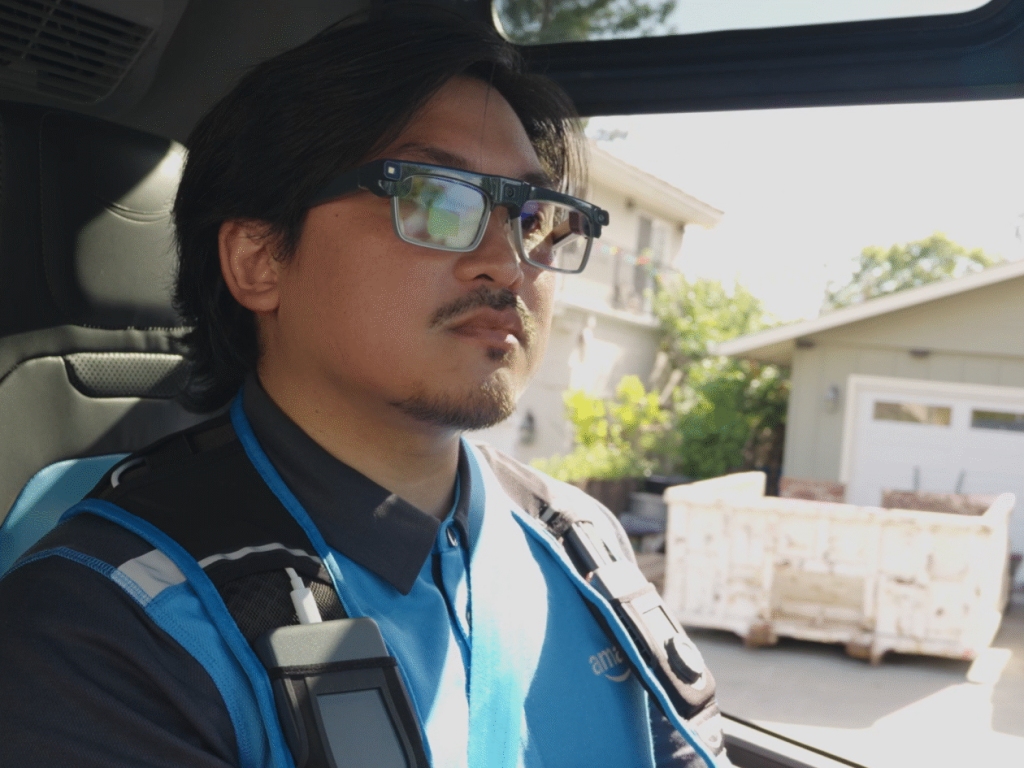Amazon’s Revolutionary AR Glasses for Delivery Drivers: A Step Toward Hands-Free Delivery
In a significant technological leap for its delivery operations, Amazon is currently testing augmented reality glasses designed specifically for its delivery drivers. Unveiled at the company’s “Delivering the Future” event in Milpitas, California, these AR glasses aim to transform how packages reach our doorsteps by bringing essential delivery information directly into drivers’ field of vision. Rather than constantly referring to handheld devices, drivers would see navigation cues, package information, and potential hazards as overlays on the real world around them. This innovation represents Amazon’s continuing push to streamline its massive delivery network while addressing safety concerns and operational efficiency.
The AR glasses work as part of an integrated wearable system that includes a controller attached to the driver’s vest, housing operational controls and a swappable battery designed to last throughout a full shift. Perhaps most notably, the vest controller features a dedicated emergency button, suggesting Amazon has incorporated safety considerations into the design from the ground up. The system has been developed with input from hundreds of drivers, according to Amazon representatives, and supports both prescription and transitional lenses to accommodate various vision needs. This human-centered approach to design may help address potential adoption barriers among the company’s diverse delivery workforce, who must contend with varying weather conditions, lighting situations, and delivery environments.
A demonstration video released by Amazon offers a glimpse into how these glasses function in real-world delivery scenarios. The system activates after the driver has safely parked their electric Rivian delivery van, overlaying the next delivery address directly onto their view. Upon approaching the cargo area, the glasses highlight specific packages needed for the current stop with green overlays, automatically scanning items as the driver picks them up and updating a virtual checklist visible only to the wearer. Perhaps most impressively, once packages are retrieved, the system projects a digital path onto the ground, guiding drivers along walkways to front doors while providing audio alerts for potential hazards such as dogs on the property. At delivery completion, drivers can capture proof-of-delivery photos by simply tapping the chest-mounted controller, eliminating fumbling with phones or handheld scanners.
While Amazon frames this technology as a safety enhancement that creates a more seamless, hands-free experience for drivers, the innovation inevitably raises questions about worker monitoring and performance expectations. Amazon has a well-documented history of implementing efficiency-driving technologies in its fulfillment centers that have sometimes pushed workers to concerning physical limits. These AR glasses, while potentially making certain aspects of delivery more convenient, also represent another avenue through which the company can track, monitor, and potentially accelerate the pace of delivery work. The ability to constantly monitor exactly what drivers see, how quickly they locate packages, and even their walking patterns to doorways creates unprecedented visibility into worker performance that could further intensify delivery targets in an already demanding job. The question remains whether this technology will primarily benefit drivers through improved ergonomics and safety, or whether it will primarily serve to extract greater productivity from Amazon’s delivery workforce.
Looking beyond immediate applications, Amazon suggests future iterations of these glasses could provide even more sophisticated features. They might offer real-time alerts about environmental hazards or notify drivers when they’re about to deliver to an incorrect address. This hints at increasingly sophisticated integration of artificial intelligence and computer vision technologies into Amazon’s delivery ecosystem. The timing is particularly notable as the enterprise AR market experiences significant shifts, with Microsoft stepping back from its HoloLens hardware development and creating opportunities for companies like Magic Leap and RealWear. Moreover, reports suggest Amazon may be developing consumer AR glasses to compete with Meta’s AI-powered Ray Ban smart glasses, indicating the company sees augmented reality as strategically important beyond just delivery applications.
Currently, these smart glasses remain in preliminary testing with hundreds of drivers across North America as Amazon gathers feedback to refine the technology before any broader implementation. The cautious rollout suggests Amazon recognizes both the potential benefits and challenges of introducing such technology into its massive delivery operation. Whether these glasses ultimately represent a genuine improvement in driver working conditions or simply another mechanism for optimizing an increasingly machine-guided workforce remains to be seen. What’s clear, however, is that Amazon continues pushing the boundaries of how technology and human labor interact in the logistics sector. As delivery demands continue growing worldwide, the success or failure of innovations like these AR glasses may significantly influence how packages arrive at our doors in the coming years, as well as the working experiences of the hundreds of thousands of people responsible for getting them there.


